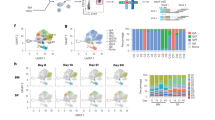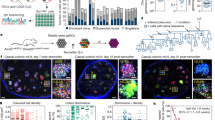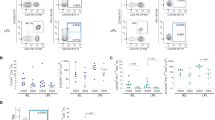Abstract
Secretory immunoglobulin A (SIgA) shields the gut epithelium from luminal antigens and contributes to host-microbe symbiosis. However, how antibody responses are regulated to achieve sustained host-microbe interactions is unknown. We found that mice and humans exhibited longitudinal persistence of clonally related B cells in the IgA repertoire despite major changes in the microbiota during antibiotic treatment or infection. Memory B cells recirculated between inductive compartments and were clonally related to plasma cells in gut and mammary glands. Our findings suggest that continuous diversification of memory B cells constitutes a central process for establishing symbiotic host-microbe interactions and offer an explanation of how maternal antibodies are optimized throughout life to protect the newborn.
This is a preview of subscription content, access via your institution
Access options
Subscribe to this journal
Receive 12 print issues and online access
$209.00 per year
only $17.42 per issue
Buy this article
- Purchase on Springer Link
- Instant access to full article PDF
Prices may be subject to local taxes which are calculated during checkout








Similar content being viewed by others
Accession codes
References
Kranich, J., Maslowski, K.M. & Mackay, C.R. Commensal flora and the regulation of inflammatory and autoimmune responses. Semin. Immunol. 23, 139–145 (2011).
Sommer, F. & Backhed, F. The gut microbiota—masters of host development and physiology. Nat. Rev. Microbiol. 11, 227–238 (2013).
Hooper, L.V., Littman, D.R. & Macpherson, A.J. Interactions between the microbiota and the immune system. Science 336, 1268–1273 (2012).
Shulzhenko, N. et al. Crosstalk between B lymphocytes, microbiota and the intestinal epithelium governs immunity versus metabolism in the gut. Nat. Med. 17, 1585–1593 (2011).
Kawamoto, S. et al. The inhibitory receptor PD-1 regulates IgA selection and bacterial composition in the gut. Science 336, 485–489 (2012).
Wei, M. et al. Mice carrying a knock-in mutation of Aicda resulting in a defect in somatic hypermutation have impaired gut homeostasis and compromised mucosal defense. Nat. Immunol. 12, 264–270 (2011).
Hapfelmeier, S. et al. Reversible microbial colonization of germ-free mice reveals the dynamics of IgA immune responses. Science 328, 1705–1709 (2010).
Lécuyer, E. et al. Segmented filamentous bacterium uses secondary and tertiary lymphoid tissues to induce gut IgA and specific T helper 17 cell responses. Immunity 40, 608–620 (2014).
Palm, N.W. et al. Immunoglobulin A coating identifies colitogenic bacteria in inflammatory bowel disease. Cell 158, 1000–1010 (2014).
Suzuki, K., Maruya, M., Kawamoto, S. & Fagarasan, S. Roles of B-1 and B-2 cells in innate and acquired IgA-mediated immunity. Immunol. Rev. 237, 180–190 (2010).
Pabst, O. New concepts in the generation and functions of IgA. Nat. Rev. Immunol. 12, 821–832 (2012).
Macpherson, A.J. et al. A primitive T cell-independent mechanism of intestinal mucosal IgA responses to commensal bacteria. Science 288, 2222–2226 (2000).
Slack, E., Balmer, M.L., Fritz, J.H. & Hapfelmeier, S. Functional flexibility of intestinal IgA—broadening the fine line. Front. Immunol. 3, 100 (2012).
Lefranc, M.P. et al. IMGT, the international ImMunoGeneTics information system. Nucleic Acids Res. 37, D1006–D1012 (2009).
Brochet, X., Lefranc, M.P. & Giudicelli, V. IMGT/V-QUEST: the highly customized and integrated system for IG and TR standardized V-J and V-D-J sequence analysis. Nucleic Acids Res. 36, W503–W508 (2008).
Lindner, C. et al. Age, microbiota, and T cells shape diverse individual IgA repertoires in the intestine. J. Exp. Med. 209, 365–377 (2012).
Larimore, K., McCormick, M.W., Robins, H.S. & Greenberg, P.D. Shaping of human germline IgH repertoires revealed by deep sequencing. J. Immunol. 189, 3221–3230 (2012).
Schloss, P.D. et al. Stabilization of the murine gut microbiome following weaning. Gut Microbes 3, 383–393 (2012).
Ben-Hamo, R. & Efroni, S. The whole-organism heavy chain B cell repertoire from Zebrafish self-organizes into distinct network features. BMC Syst. Biol. 5, 27 (2011).
Tomayko, M.M., Steinel, N.C., Anderson, S.M. & Shlomchik, M.J. Cutting edge: hierarchy of maturity of murine memory B cell subsets. J. Immunol. 185, 7146–7150 (2010).
Bergqvist, P. et al. Re-utilization of germinal centers in multiple Peyer's patches results in highly synchronized, oligoclonal, and affinity-matured gut IgA responses. Mucosal Immunol. 6, 122–135 (2013).
Ugur, M., Schulz, O., Menon, M.B., Krueger, A. & Pabst, O. Resident CD4+ T cells accumulate in lymphoid organs after prolonged antigen exposure. Nat. Commun. 5, 4821 (2014).
Schulz, O. et al. Hypertrophy of infected Peyer's patches arises from global, interferon-receptor, and CD69-independent shutdown of lymphocyte egress. Mucosal Immunol. 7, 892–904 (2014).
Brandtzaeg, P. The mucosal immune system and its integration with the mammary glands. J. Pediatr. 156, S8–S15 (2010).
Di Niro, R. et al. High abundance of plasma cells secreting transglutaminase 2–specific IgA autoantibodies with limited somatic hypermutation in celiac disease intestinal lesions. Nat. Med. 18, 441–445 (2012).
Di Niro, R. et al. Rapid generation of rotavirus-specific human monoclonal antibodies from small-intestinal mucosa. J. Immunol. 185, 5377–5383 (2010).
McHeyzer-Williams, L.J., Milpied, P.J., Okitsu, S.L. & McHeyzer-Williams, M.G. Class-switched memory B cells remodel BCRs within secondary germinal centers. Nat. Immunol. 16, 296–305 (2015).
Peterson, D.A., McNulty, N.P., Guruge, J.L. & Gordon, J.I. IgA response to symbiotic bacteria as a mediator of gut homeostasis. Cell Host Microbe 2, 328–339 (2007).
Wang, F. et al. Reshaping antibody diversity. Cell 153, 1379–1393 (2013).
Jenne, C.N., Kennedy, L.J. & Reynolds, J.D. Antibody repertoire development in the sheep. Dev. Comp. Immunol. 30, 165–174 (2006).
Spencer, J., Klavinskis, L.S. & Fraser, L.D. The human intestinal IgA response; burning questions. Front. Immunol. 3, 108 (2012).
Dunn-Walters, D.K., Boursier, L. & Spencer, J. Hypermutation, diversity and dissemination of human intestinal lamina propria plasma cells. Eur. J. Immunol. 27, 2959–2964 (1997).
Barone, F. et al. IgA-producing plasma cells originate from germinal centers that are induced by B-cell receptor engagement in humans. Gastroenterology 140, 947–956 (2011).
Bergqvist, P., Stensson, A., Lycke, N.Y. & Bemark, M. T cell-independent IgA class switch recombination is restricted to the GALT and occurs prior to manifest germinal center formation. J. Immunol. 184, 3545–3553 (2010).
Weller, S. et al. CD40–CD40L independent Ig gene hypermutation suggests a second B cell diversification pathway in humans. Proc. Natl. Acad. Sci. USA 98, 1166–1170 (2001).
Scheeren, F.A. et al. T cell-independent development and induction of somatic hypermutation in human IgM+ IgD+ CD27+ B cells. J. Exp. Med. 205, 2033–2042 (2008).
Vossenkämper, A. et al. A role for gut-associated lymphoid tissue in shaping the human B cell repertoire. J. Exp. Med. 210, 1665–1674 (2013).
Casola, S. et al. B cell receptor signal strength determines B cell fate. Nat. Immunol. 5, 317–327 (2004).
de Vinuesa, C.G. et al. Germinal centers without T cells. J. Exp. Med. 191, 485–494 (2000).
Shlomchik, M.J. & Weisel, F. Germinal center selection and the development of memory B and plasma cells. Immunol. Rev. 247, 52–63 (2012).
Boysen, P., Eide, D.M. & Storset, A.K. Natural killer cells in free-living Mus musculus have a primed phenotype. Mol. Ecol. 20, 5103–5110 (2011).
Gaboriau-Routhiau, V. et al. The key role of segmented filamentous bacteria in the coordinated maturation of gut helper T cell responses. Immunity 31, 677–689 (2009).
Edgar, R.C. Search and clustering orders of magnitude faster than BLAST. Bioinformatics 26, 2460–2461 (2010).
Shannon, P. et al. Cytoscape: a software environment for integrated models of biomolecular interaction networks. Genome Res. 13, 2498–2504 (2003).
Cline, M.S. et al. Integration of biological networks and gene expression data using Cytoscape. Nat. Protoc. 2, 2366–2382 (2007).
Magurran, A.E. Ecological Diversity and Its Measurement. (Princeton University Press, 1988).
Caporaso, J.G. et al. QIIME allows analysis of high-throughput community sequencing data. Nat. Methods 7, 335–336 (2010).
Wang, Q., Garrity, G.M., Tiedje, J.M. & Cole, J.R. Naive Bayesian classifier for rapid assignment of rRNA sequences into the new bacterial taxonomy. Appl. Environ. Microbiol. 73, 5261–5267 (2007).
Schulz, O. et al. Intestinal CD103+, but not CX3CR1+, antigen sampling cells migrate in lymph and serve classical dendritic cell functions. J. Exp. Med. 206, 3101–3114 (2009).
Naumov, Y.N., Naumova, E.N., Hogan, K.T., Selin, L.K. & Gorski, J. A fractal clonotype distribution in the CD8+ memory T cell repertoire could optimize potential for immune responses. J. Immunol. 170, 3994–4001 (2003).
Acknowledgements
We thank U. Kalinke (TWINCORE, Hannover, Germany), A. Krueger, I. Prinz, O. Schulz, S. Woltemate (Hannover Medical School, Hannover, Germany), M. Bemark (University of Gothenburg, Gothenburg, Sweden), B. Wabakken Hognestad and D. Ölsner (both at the Norwegian University of Life Sciences, Oslo, Norway), and R. Bharti (IKMB, University of Kiel, Kiel, Germany). This work was supported by the DFG Cluster of Excellence Inflammation at Interfaces (CL VIII to P.R., S.O. and S. Schreiber), the BMBF (grant SysINFLAME (TP3/4) to P.R.), the Israel Science Foundation (grant 270/09 to R.M.), the German Centre for Infection Research (DZIF), partner site Hannover-Braunschweig and Deutsche Forschungsgemeinschaft (grants PA921/4-1 (to O.P.) and SFB621-Z).
Author information
Authors and Affiliations
Contributions
C.L. and I.T. performed experiments and analyzed data; M.U. performed cell-tracking experiments; B.W. generated tools for data analysis; M.F., M.K.S. and S. Suerbaum supported sequencing experiments; A.B. and A.S. performed colonization experiments; V.G.-R. and N.C.-B. provided samples from monocolonized mice; H.H. and R.M. helped with sequencing data analysis; P.B. performed cohousing experiments; S.O., U.B., S. Schreiber and P.R. provided human samples; and O.P. performed mouse surgery, designed the study and wrote the manuscript.
Corresponding author
Ethics declarations
Competing interests
The authors declare no competing financial interests.
Integrated supplementary information
Supplementary Figure 1 Exponential Shannon index as a measure of immunoglobulin repertoire diversity.
(a) The IgA repertoire was sequenced in samples containing defined numbers of sorted IgA+ intestinal plasma cells (n = 4, pooled from two independent experiments). The maximum exponent Shannon was considered as 100% diversity. The exponent Shannon was determined for all samples, and varying numbers of sequences were used for analysis. Analysis of 4,000 sequences was sufficient to reach 95% of maximum diversity for all samples. 2,000 sequences were sufficient to comprehensively describe diversity in samples comprising 5,000 or fewer plasma cells. (b) The exponent Shannon was determined in samples containing 5,000 sorted IgA+ plasma cells either from single mice or pooled from two, four or six mice. Symbols represent independent experiments and analysis of 2,000 sequences each.
Supplementary Figure 2 Modulation of the microbiota by SPF colonization.
Germ-free mice were monocolonized with E. coli Nissle (ECN) for 4 weeks. Subsequently, biopsies of small intestine were taken and mice were gavaged with cecal content from donor SPF mice housed at the central animal facility at Hannover Medical School. After another 4 weeks, 16S rDNA was sequenced to analyze the bacterial composition in the small intestine and feces of recipient mice. Bacterial 16S rDNA sequences were analyzed with Qiime, an open source software package for the analysis of microbial communities. Qiime was also used to determine the diversity of the microbiota. Microbial diversity was comparable between donor and recipient mice (Shannon index calculated based on 2,236 sequences: donor SI, 6.181 ± 0.343; recipient SI, 5.835 ± 0.174; donor feces, 6.886 ± 0.094; recipient feces, 6.713 ± 0.110). Bar diagrams display families contributing more than 2% of all sequences. Data from two independent experiments were pooled.
Supplementary Figure 3 Separation of expanded and non-expanded components in the IgA repertoire.
Clusters were assigned a rank on the basis of abundance, and the frequency of all ranks was determined. Log(frequency) versus log(rank) diagrams are depicted for representative mice. The first component comprised low-frequency clones and showed power law characteristics (I), whereas the second component (II) comprised expanded clones that appeared as a long tail (gray symbols) in log(frequency) versus log(rank) diagrams. Diagrams represent, from top to bottom, (1) wild-type mice (n = 6) and MyD88/Trif double-deficient mice housed under SPF conditions at Hannover Medical School (n = 3), (2) germ-free mice (n = 7) and germ-free mice monocolonized for 4 weeks with ECN (n = 10; as described for Fig. 1), and (3) wild-type mice housed under SPF conditions at the Norwegian School of Veterinary Science (n = 5) or housed for 8 weeks together with wild-caught mice in an enriched environment (n = 5). Representative data from five independent experiments are displayed.
Supplementary Figure 4 Modulation of the microbiota by antibiotic treatment.
Biopsies of small intestine were obtained from 7- or 9-week-old C57BL/6 mice housed under SPF conditions. One week after surgery, mice received a cocktail of ampicillin and vancomycin in the drinking water, and this antibiotic administration continued for 4 weeks. Fecal samples were collected before and after antibiotic treatment to track changes in the microbiota by 16S rDNA sequencing. Microbial diversity was reduced after antibiotic treatment (Shannon index calculated based on 1,321 sequences: 6.526 ± 0.222 before and 3.973 ± 1.668 after treatment, mean ± s.d., n = 6). Of note, chloroplast sequences likely reflect food-derived sequences and are not part of the proper intestinal microbiota. We did not exclude these sequences from the analysis, in order to preserve the integrity of the data set. Operational taxonomic units generated by Qiime analysis of 16S rDNA sequences before and after antibiotic treatment were clustered using weighted UniFrac principle coordinate analysis. Data from two independent experiments are displayed.
Supplementary Figure 5 The intestinal IgA plasma cell repertoire mirrors the IgA memory B cell compartment.
(a) PP B cells, excluding plasma cells and germinal center cells (DAPI−CD19+CD138−GL7−), were sorted as CD80−CD73− (enriched in naive B cells) and memory B cells (CD80+CD73+). IgA plasma cells were sorted from intestinal lamina propria (IgA+CD138+ single cells). (b) IgA and IgM repertoire sequence information was obtained from sorted memory B cells and compared to the IgM repertoire of naïve B cells and the IgA repertoire of intestinal plasma cells. 1,000 sequences per sample were clustered with 95% CDR3 sequence identity and displayed as a network. Sample origin is indicated by color code. Asterisks mark clusters comprising gut plasma cells and IgA memory B cells. Morisita-Horn indices (MHI) were calculated comparing the IgA plasma cell repertoire to the PP B cell and memory B cell repertoires as indicated (n = 5). Data were pooled and represent three independent experiments.
Supplementary Figure 6 Memory B cells and plasma cells show frequent somatic mutations.
(a) PP B cells, PP memory B cells and lamina propria IgA plasma cells were isolated and sorted as described for Figure 7. IgA and IgM repertoires were analyzed, and the number of mutations was determined. Bars depict mutation frequencies for framework regions 1–3 (FR1–3) and complementarity-determining regions (CDRs) 1 and 2 (n = 3, mean + s.d.). (b) 4,000 sequences each from IgA plasma cells (IgA PCs) and IgA memory B cells were clustered with 95% CDR3 sequence identity. All CDR3 clusters present in both cell populations and represented by at least five sequences were identified, and the average number of mutations was determined for each cluster. Data for three representative animals out of six animals analyzed are displayed. Paired t-test was used for statistical analysis, **P < 0.01, ***P < 0.001. Data were pooled and represent three independent experiments.
Supplementary information
Supplementary Text and Figures
Supplementary Figures 1–6, Supplementary Table 1 and Supplementary Note (PDF 2349 kb)
Rights and permissions
About this article
Cite this article
Lindner, C., Thomsen, I., Wahl, B. et al. Diversification of memory B cells drives the continuous adaptation of secretory antibodies to gut microbiota. Nat Immunol 16, 880–888 (2015). https://doi.org/10.1038/ni.3213
Received:
Accepted:
Published:
Issue Date:
DOI: https://doi.org/10.1038/ni.3213
This article is cited by
-
Memory B cells
Nature Reviews Immunology (2023)
-
Tango of B cells with T cells in the making of secretory antibodies to gut bacteria
Nature Reviews Gastroenterology & Hepatology (2023)
-
Human intestinal B cells in inflammatory diseases
Nature Reviews Gastroenterology & Hepatology (2023)
-
The role of retinoic acid in the production of immunoglobulin A
Mucosal Immunology (2022)
-
The effects of probiotic supplementation on the gene expressions of immune cell surface markers and levels of antibodies and pro-inflammatory cytokines in human milk
Journal of Perinatology (2021)



